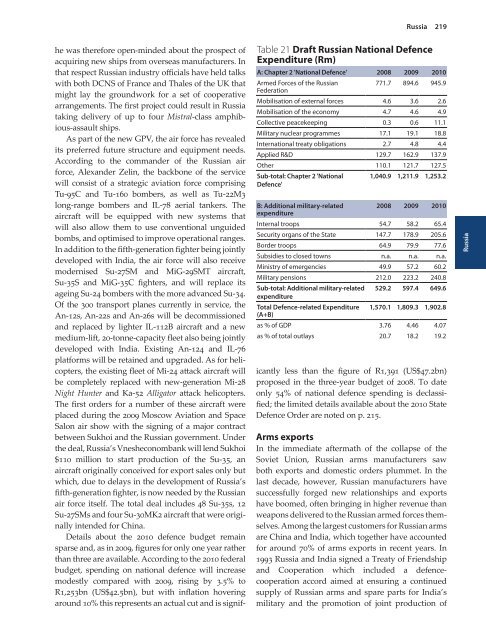You also want an ePaper? Increase the reach of your titles
YUMPU automatically turns print PDFs into web optimized ePapers that Google loves.
he was therefore open-minded about the prospect of<br />
acquiring new ships from overseas manufacturers. In<br />
that respect Russian industry officials have held talks<br />
with both DCNS of France and Thales of the UK that<br />
might lay the groundwork for a set of cooperative<br />
arrangements. The first project could result in Russia<br />
taking delivery of up to four Mistral-class amphibious-assault<br />
ships.<br />
As part of the new GPV, the air force has revealed<br />
its preferred future structure and equipment needs.<br />
According to the commander of the Russian air<br />
force, Alexander Zelin, the backbone of the service<br />
will consist of a strategic aviation force comprising<br />
Tu-95C and Tu-160 bombers, as well as Tu-22M3<br />
long-range bombers and IL-78 aerial tankers. The<br />
aircraft will be equipped with new systems that<br />
will also allow them to use conventional unguided<br />
bombs, and optimised to improve operational ranges.<br />
In addition to the fifth-generation fighter being jointly<br />
developed with India, the air force will also receive<br />
modernised Su-27SM and MiG-29SMT aircraft,<br />
Su-35S and MiG-35C fighters, and will replace its<br />
ageing Su-24 bombers with the more advanced Su-34.<br />
Of the 300 transport planes currently in service, the<br />
An-12s, An-22s and An-26s will be decommissioned<br />
and replaced by lighter IL-112B aircraft and a new<br />
medium-lift, 20-tonne-capacity fleet also being jointly<br />
developed with India. Existing An-124 and IL-76<br />
platforms will be retained and upgraded. As for helicopters,<br />
the existing fleet of Mi-24 attack aircraft will<br />
be completely replaced with new-generation Mi-28<br />
Night Hunter and Ka-52 Alligator attack helicopters.<br />
The first orders for a number of these aircraft were<br />
placed during the 2009 Moscow Aviation and Space<br />
Salon air show with the signing of a major contract<br />
between Sukhoi and the Russian government. Under<br />
the deal, Russia’s Vnesheconombank will lend Sukhoi<br />
$110 million to start production of the Su-35, an<br />
aircraft originally conceived for export sales only but<br />
which, due to delays in the development of Russia’s<br />
fifth-generation fighter, is now needed by the Russian<br />
air force itself. The total deal includes 48 Su-35s, 12<br />
Su-27SMs and four Su-30MK2 aircraft that were originally<br />
intended for China.<br />
Details about the 2010 defence budget remain<br />
sparse and, as in 2009, figures for only one year rather<br />
than three are available. According to the 2010 federal<br />
budget, spending on national defence will increase<br />
modestly compared with 2009, rising by 3.5% to<br />
R1,253bn (US$42.5bn), but with inflation hovering<br />
around 10% this represents an actual cut and is signif-<br />
Russia<br />
Table 21 draft Russian National defence<br />
expenditure (Rm)<br />
219<br />
a: chapter 2 'national Defence' 2008 2009 2010<br />
Armed Forces of the Russian<br />
Federation<br />
771.7 894.6 945.9<br />
Mobilisation of external forces 4.6 3.6 2.6<br />
Mobilisation of the economy 4.7 4.6 4.9<br />
Collective peacekeeping 0.3 0.6 11.1<br />
Military nuclear programmes 17.1 19.1 18.8<br />
International treaty obligations 2.7 4.8 4.4<br />
Applied R&D 129.7 162.9 137.9<br />
Other 110.1 121.7 127.5<br />
Sub-total: chapter 2 'national<br />
Defence'<br />
1,040.9 1,211.9 1,253.2<br />
B: additional military-related<br />
expenditure<br />
2008 2009 2010<br />
Internal troops 54.7 58.2 65.4<br />
Security organs of the State 147.7 178.9 205.6<br />
Border troops 64.9 79.9 77.6<br />
Subsidies to closed towns n.a. n.a. n.a.<br />
Ministry of emergencies 49.9 57.2 60.2<br />
Military pensions 212.0 223.2 240.8<br />
Sub-total: additional military-related<br />
expenditure<br />
529.2 597.4 649.6<br />
Total Defence-related expenditure<br />
(a+B)<br />
1,570.1 1,809.3 1,902.8<br />
as % of GDP 3.76 4.46 4.07<br />
as % of total outlays 20.7 18.2 19.2<br />
icantly less than the figure of R1,391 (US$47.2bn)<br />
proposed in the three-year budget of 2008. To date<br />
only 54% of national defence spending is declassified;<br />
the limited details available about the 2010 State<br />
Defence Order are noted on p. 215.<br />
arms exports<br />
In the immediate aftermath of the collapse of the<br />
Soviet Union, Russian arms manufacturers saw<br />
both exports and domestic orders plummet. In the<br />
last decade, however, Russian manufacturers have<br />
successfully forged new relationships and exports<br />
have boomed, often bringing in higher revenue than<br />
weapons delivered to the Russian armed forces themselves.<br />
Among the largest customers for Russian arms<br />
are China and India, which together have accounted<br />
for around 70% of arms exports in recent years. In<br />
1993 Russia and India signed a Treaty of Friendship<br />
and Cooperation which included a defence-<br />
cooperation accord aimed at ensuring a continued<br />
supply of Russian arms and spare parts for India’s<br />
military and the promotion of joint production of<br />
Russia


